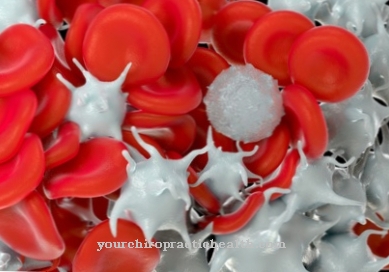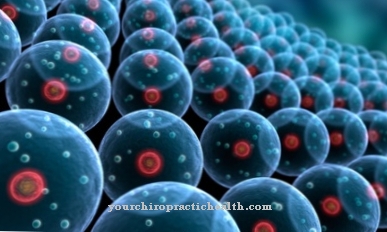The Maximum strength is the highest possible force that an organism can muster against resistance. It is influenced by internal factors, such as muscle composition, and external factors, such as the time of day. If there are structural changes in the contractile components, the maximum force is reduced.
What is the maximum strength?

Sports medicine knows different types of strength. All of them affect the neuromuscular system and help overcome resistance. In addition to the reactive force, the maximum force is one of the most important types of force. The maximum force is the maximum force that a person can muster to overcome a resistance. More strength than the maximum strength is only available to people in exceptional situations, for example in the context of traumatic and life-threatening experiences or under certain hypnosis techniques. The more power in these situations is made up of the power reserves, which combine with the maximum power to form the absolute power.
The maximum force depends on both internal and external factors. The number of muscle fibers, for example, as an internal factor, has an influence on the maximum possible effort. External influencing factors include relationships such as the time of day.
Function & task
The maximum strength is the basis for strength properties such as strength endurance, speed strength and reactive strength. It can be divided into different categories. One of them is the static maximum force, which is also called the isometric maximum force. The maximum holding force, for example, falls into this category. The type of force corresponds to the greatest possible force that the nerve-muscle system can exert against a resistance that is insurmountable.
The dynamic maximum force must be distinguished from this. This type of force refers to movements in which the force can be applied only once and only under previously defined conditions due to the high stress. The muscles know different ways of working. Depending on the working method, the dynamic maximum force is divided into concentric and eccentric dynamic maximum force. The concentric way of working corresponds to overcoming maximum resistance.
The eccentric mode of operation is when lowering maximum weights.The dynamic types of force differ in their height from the static maximum force. The concentric dynamic maximum force, for example, is located below the static. The static maximum force is in turn below the eccentric dynamic maximum force. Eccentric maximum force is understood by some sources as the metrological representation of an absolute force.
By distinguishing between eccentric and isometric maximum strength, an individual strength deficit can be determined. This strength deficit can be used for training planning. A high strength deficit, for example, indicates a low level of intramuscular coordination. These properties can be improved through maximum strength training. Hypertrophy training, on the other hand, increases muscle thickness and helps improve general strength skills.
They are suitable for training planning with low strength deficits and with a correspondingly high intramuscular coordination. Some authors consider it inadmissible to differentiate between the individual forms of contraction, since they are all based on a uniform ability. For this reason, there are also sources that do not break down the individual forms of contraction and describe all of them under the broader term of maximum force.
Various factors determine the maximum strength. Internal factors include, for example, muscle thickness. The greater the thickness, the higher the contained contraction elements actin and myosin. In addition, the number of muscle fibers, the ratio of fiber types and the structure of the muscles are some of the internal factors influencing maximum strength.
The same applies to the interaction of the synergistic muscles, the process of muscle control by the nerves, the interaction of individual muscle fibers and the length of the muscle fibers. The tension angle, the elasticity of the muscles, the static maximum strength and the muscle stretching also play a role as internal factors of the maximum strength. It is also about the speed of contraction, the psycho-mental level of motivation and concentration.
Because of the average (not absolute) different muscle proportions of the sexes, sex is also to be assessed as an influencing factor. Age and level of training, as well as diet and level of preparation, complete the list of internal factors. In addition to the time of day and the ambient temperature, external influencing factors include, for example, external motivation.
You can find your medication here
➔ Medicines for muscle weaknessIllnesses & ailments
The maximum strength varies from person to person. Someone with a sedentary lifestyle and poor nutritional status will automatically have less maximum strength. Such differences are not necessarily pathological and therefore do not necessarily have disease value.
On the other hand, various diseases can also limit a person's maximum strength. This is especially true for diseases of the neuromuscular system. In particular, diseases that are directly related to the contractile elements of the muscles have a negative impact on maximum strength. Such diseases include, for example, structural changes in the muscle element myosin, which can be caused by genetic mutations and cause serious muscle diseases. One of the best-known examples from this group of diseases is familial hypertrophic cardiomyopathy, which is subject to autosomal dominant inheritance and can cause heart failure.
The term myopathy includes many other diseases that are inherent diseases of the muscles and thus limit the maximum strength. Myopathies have no neuronal cause, but are always characterized by a weakness of the muscles. In all myopathies there are structural changes and mostly functional impairments in the muscle. The striated skeletal muscles are most commonly affected. Most myopathies are mild. Some of the muscle weaknesses are temporary.
A deficiency or defect in the contractile muscle structure protein actin can also have consequences for maximum strength. Actin is an essential part of all cells. In extreme cases, mutations and structural changes in the protein can even lead to the death of the organism. When the mutations affect the coding genes for alpha-actins, muscle disorders occur.



























